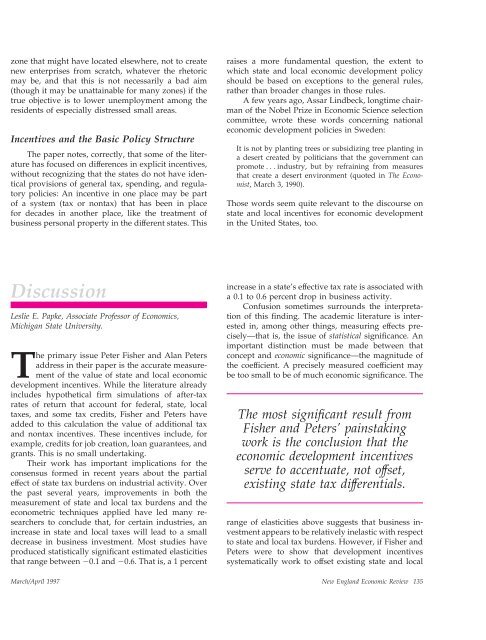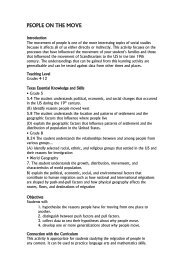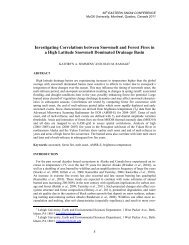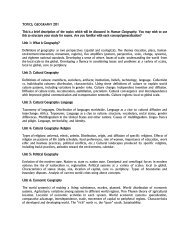Tax and Spending Incentives and Enterprise Zones - Department of ...
Tax and Spending Incentives and Enterprise Zones - Department of ...
Tax and Spending Incentives and Enterprise Zones - Department of ...
Create successful ePaper yourself
Turn your PDF publications into a flip-book with our unique Google optimized e-Paper software.
zone that might have located elsewhere, not to create<br />
new enterprises from scratch, whatever the rhetoric<br />
may be, <strong>and</strong> that this is not necessarily a bad aim<br />
(though it may be unattainable for many zones) if the<br />
true objective is to lower unemployment among the<br />
residents <strong>of</strong> especially distressed small areas.<br />
<strong>Incentives</strong> <strong>and</strong> the Basic Policy Structure<br />
The paper notes, correctly, that some <strong>of</strong> the literature<br />
has focused on differences in explicit incentives,<br />
without recognizing that the states do not have identical<br />
provisions <strong>of</strong> general tax, spending, <strong>and</strong> regulatory<br />
policies: An incentive in one place may be part<br />
<strong>of</strong> a system (tax or nontax) that has been in place<br />
for decades in another place, like the treatment <strong>of</strong><br />
business personal property in the different states. This<br />
Discussion<br />
Leslie E. Papke, Associate Pr<strong>of</strong>essor <strong>of</strong> Economics,<br />
Michigan State University.<br />
The primary issue Peter Fisher <strong>and</strong> Alan Peters<br />
address in their paper is the accurate measurement<br />
<strong>of</strong> the value <strong>of</strong> state <strong>and</strong> local economic<br />
development incentives. While the literature already<br />
includes hypothetical firm simulations <strong>of</strong> after-tax<br />
rates <strong>of</strong> return that account for federal, state, local<br />
taxes, <strong>and</strong> some tax credits, Fisher <strong>and</strong> Peters have<br />
added to this calculation the value <strong>of</strong> additional tax<br />
<strong>and</strong> nontax incentives. These incentives include, for<br />
example, credits for job creation, loan guarantees, <strong>and</strong><br />
grants. This is no small undertaking.<br />
Their work has important implications for the<br />
consensus formed in recent years about the partial<br />
effect <strong>of</strong> state tax burdens on industrial activity. Over<br />
the past several years, improvements in both the<br />
measurement <strong>of</strong> state <strong>and</strong> local tax burdens <strong>and</strong> the<br />
econometric techniques applied have led many researchers<br />
to conclude that, for certain industries, an<br />
increase in state <strong>and</strong> local taxes will lead to a small<br />
decrease in business investment. Most studies have<br />
produced statistically significant estimated elasticities<br />
that range between 0.1 <strong>and</strong> 0.6. That is, a 1 percent<br />
raises a more fundamental question, the extent to<br />
which state <strong>and</strong> local economic development policy<br />
should be based on exceptions to the general rules,<br />
rather than broader changes in those rules.<br />
A few years ago, Assar Lindbeck, longtime chairman<br />
<strong>of</strong> the Nobel Prize in Economic Science selection<br />
committee, wrote these words concerning national<br />
economic development policies in Sweden:<br />
It is not by planting trees or subsidizing tree planting in<br />
a desert created by politicians that the government can<br />
promote ...industry, but by refraining from measures<br />
that create a desert environment (quoted in The Economist,<br />
March 3, 1990).<br />
Those words seem quite relevant to the discourse on<br />
state <strong>and</strong> local incentives for economic development<br />
in the United States, too.<br />
increase in a state’s effective tax rate is associated with<br />
a 0.1 to 0.6 percent drop in business activity.<br />
Confusion sometimes surrounds the interpretation<br />
<strong>of</strong> this finding. The academic literature is interested<br />
in, among other things, measuring effects precisely—that<br />
is, the issue <strong>of</strong> statistical significance. An<br />
important distinction must be made between that<br />
concept <strong>and</strong> economic significance—the magnitude <strong>of</strong><br />
the coefficient. A precisely measured coefficient may<br />
be too small to be <strong>of</strong> much economic significance. The<br />
The most significant result from<br />
Fisher <strong>and</strong> Peters’ painstaking<br />
work is the conclusion that the<br />
economic development incentives<br />
serve to accentuate, not <strong>of</strong>fset,<br />
existing state tax differentials.<br />
range <strong>of</strong> elasticities above suggests that business investment<br />
appears to be relatively inelastic with respect<br />
to state <strong>and</strong> local tax burdens. However, if Fisher <strong>and</strong><br />
Peters were to show that development incentives<br />
systematically work to <strong>of</strong>fset existing state <strong>and</strong> local<br />
March/April 1997 New Engl<strong>and</strong> Economic Review 135
















